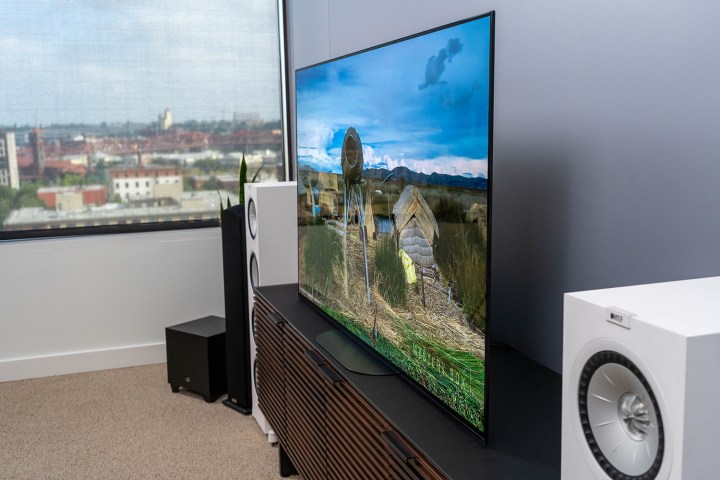We can’t fault the Sony Master Series A9G. It’s the finest 4K TV we’ve had the pleasure of reviewing. However, it’s not all that different from the cheaper, (slightly) lower-end Sony A8G. But what are these differences — and most importantly, are they worth the additional $1,000-$1,300 Sony is asking for the flagship Sony A9G? Let’s find out.
Soundbar? No chance
First up, design. There isn’t a whole lot of difference between the Sony A9G and the Sony A8G in this regard. The latest model comes with a sleeker, slimmer stand that leaves almost no space between the bottom of the television and the surface it is resting on. The bezel surrounding the screen is also a bit thinner and the rear doesn’t protrude quite as much.
All in all, the space reductions are minor details that we wouldn’t even have mentioned if we weren’t in the business of painting as clear and accurate a picture as possible — with the stand being the biggest visual difference. Of course, this is something that’s bound to be controversial as the new design leaves virtually no space for a soundbar to rest beneath the screen when stand-mounted.

Also worth mentioning is the addition of an eARC HDMI slot on the Sony Master Series A9G (not to be confused with HDMI 2.1, which neither the A9G or A8G support). We have a full explainer detailing what eARC is and why it’s useful, so we won’t run into it now. In a nutshell, it’s HDMI ARC with the addition of original, full-resolution audio transmission through HDMI.
Kick, punch, thud
Plus, Sony has (marginally) improved its trademark Acoustic Surface tech on the Sony Master Series A9G. For those unaware, this eliminates bulky speakers on the front of the television by sending waves through the screen itself — creating a unique effect of voices and sound effects seemingly coming from their respective locations on the screen (left, right, or center).
The difference with the Sony Master Series A9G is that Acoustic Surface is twice as powerful — on paper, at least. Sony says that three of the four channels have been bumped up from 10W up to 20W. Although, this doesn’t translate to a much better viewing experience. The two televisions sound near-identical, save for the fact the A9G has a little bit more kick to it.

Let’s face it, though: If you’re splashing out north of $1,000 for a television, you’re going to be hooking it up to at least a soundbar, if not an entire surround sound setup — so the rumble Acoustic Surface makes will go unnoticed. Better yet, the Sony Master Series A9G can be used as a center channel speaker, via a terminal on the rear, whereas the Sony A8G cannot.
Let’s get real deep
The Sony Master Series A9G and Sony Master Series A8G feature the same 4K Ultra HD OLED screen. However, the A9G is equipped with Sony’s leading Sony X1 Ultimate picture processor, versus the Sony X1 Extreme on the more affordable A8G. The main advantage here is that the top-of-the-line version is better at object-based processing, which results in better depth.

For
Elegant, but not necessary
Finally, the Sony A9G comes bundled with a slightly more elegant remote control, which functions in the exact same way as the one bundled with the A8G, and souped-up hardware that delivers a smoother Android TV experience. Having said that, while a bit sluggish at times, Android TV is just as functional on the A8G — so don’t consider this reason alone to upgrade.
So, which do you need?
The bottom line is there just isn’t enough of a difference between the Sony Master Series A9G and the Sony A8G to warrant the $1,000 to $1,300 price hike, depending on the screen size you opt for. Sure, if money is no object and you’re insistent on having the best of the best, opt for the Sony A9G. For everyone else, the Sony A8G is definitely the way to go.
Editors' Recommendations
- Sony debuts the Bravia 9, its brightest 4K TV ever, alongside new 2024 models
- The best 8K TVs for 2024: from Samsung, LG, and Sony
- Hisense kicks off its U8K mini-LED TV availability with deep discounts
- Projectors vs. TVs: Which is best for your home theater?
- 8K TV: Everything you need to know about television’s future





